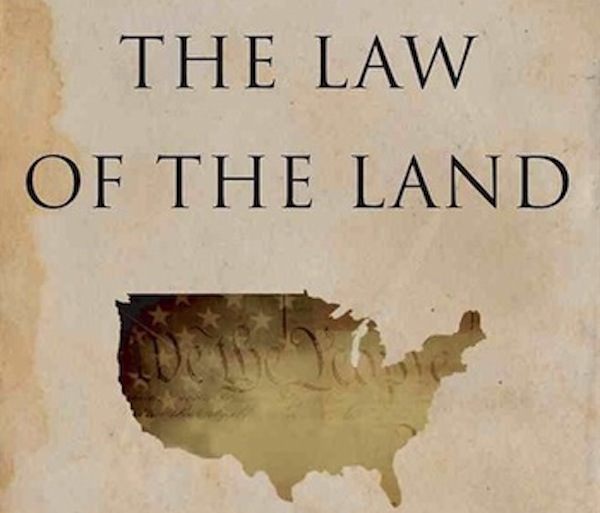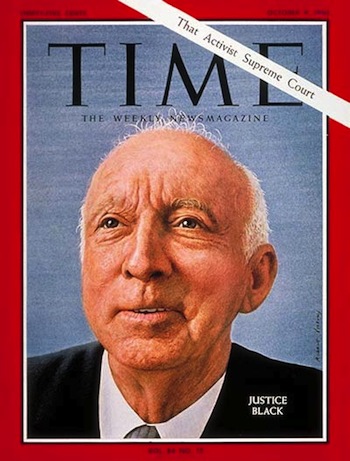Book Review: “The Law of the Land” — How Geography Influenced the Constitution
It is nice to know that there is someone as cultivated and enthusiastic about constitutional history as Professor Akhil Reed Amar.
The Law of the Land: A Grand Tour of our Constitutional Republic by Akhil Reed Amar. Basic Books, 376 pp, $29.99

By Blake Maddux
Akhil Reed Amar is an interesting character.
Given the titles of three of his books — America’s Unwritten Constitution: The Precedent and Principles We Live By, America’s Constitution: A Biography, and The Bill of Rights: Creation and Reconstruction — it should surprise no one that he holds the title of Sterling Professor of Law and Political Science at Yale University. His physical appearance alone — prominent round eyeglasses, full and graying beard, somewhat unkempt head of hair — makes guessing his brainy profession a no-brainer.
Hear him speak, however, and one would think that this preeminent scholar of constitutional law keeps a surfboard in his office at Yale Law School. As grin-inducing as his northern California accent may be, especially given its contrast with his professorial countenance, getting past it and hearing what he has to say can be most rewarding.
Fortunately, hearing his voice is not an issue when it comes to reading any of the aforementioned titles or his most recent one, The Law of the Land: A Grand Tour of Our Constitutional Republic. In this book, which is surely his most accessible thus far, Amar aims to explain how the phenomenon of geography — i.e., the interaction among topography, population, and location — has impacted and been impacted by the nation’s governing document.
While nothing that I write is going to undermine Amar’s status as one of the most important legal scholars in the nation, I personally found The Law of the Land to be quite engaging in some parts, less so in others, and not particularly riveting at all in the remaining ones.
Let us start with the conclusion, in which Amar writes, “The wideness of the Atlantic, the flatness of the Midwest, and the centrality of the Mississippi were all important factors influencing the Founders’ and Lincoln’s view of the secession question … Geography’s complex interaction with law and culture lies close the surface of my opening chapter on Lincoln; but other chapters should also be understood in this light.”
However, if I had Amar’s job, and I asked my students to write essays about how New York, Wyoming, and New Jersey influenced constitutional history from a geographical perspective, well, let’s just say that I would have to be feeling pretty generous to give a passing grade to the students who submitted the answers found in The Law of the Land.
This is not because the chapters are neither interesting nor informative. It is because they fail to capture how the aforementioned phenomenon of geography was significant in relation to the states. The name “Wyoming” is mentioned on only five of the 25 pages that make up the chapter titled “Wyoming: A Rocky-Mountain View of the Second Amendment,” and the author fails to grapple with the Cowboy State’s unique relationship with the right to keep and bear arms. (He does, however, call the Fourteenth Amendment as something of a surprise witness in defense of private gun ownership.)

Time magazine cover featuring Supreme Court Justice Hugo Black.
The chapter on the Garden State, meanwhile, does little more in terms of geographical discussion than point out that “the New Jersey city closest to Independence Hall was named for a great jurist [Lord Camden] who insisted that judges and juries must always enjoy sufficient power to ensure that fundamental rights remain the law of the land.” So what? How is that constitutionally meaningful as it applies to topography, population, and location?
In the Texas section of The Law of the Land, Amar conducts a thought experiment in which he explains how two people from the Lone Star State — Jeb Bush and Ted Cruz — could constitutionally occupy the White House together for a total of four terms. Fine, but Bush is not a Texan. He moved to Florida shortly after the 1980 election that made his father the Vice President of the United States. If the author wanted to use an example of how a team of two individuals from the same state could, in accord with the Constitution, head up the executive branch for 16 years, he could have used Marco Rubio instead of Cruz.
Amar must know that, for purposes of running for president, Bush is not a Texan because only a few pages before he defends Dick Cheney’s July 2000 decision to make Wyoming his home so that there would not be two Texas residents on the GOP ticket.
Ironically, by the time that a reader is done with a chapter, he or she is likely to be too mesmerized, confused, or overwhelmed by the depth and breadth of Amar’s knowledge to bother wondering what his point was to begin with.
That is not to say that none of the sections are at all in line with the volume’s apparent purpose.
In fact, the book starts out promisingly with a chapter on Illinois and Abraham Lincoln, whom Amar calls “the most significant constitutional interpreter and decision-maker of the past two centuries.”
The following chapter is devoted to the Alabama-born Supreme Court justice Hugo Black, who Amar argues carried the baton at some point after Lincoln in the race to make the Constitution a more perfect document. Amar declares that Black provided the “intellectual backbone” of the controversial Warren Court, the one that liberals love and conservatives love to hate.
Thankfully, Amar acknowledges that his Supreme Court hero was a member of Alabama’s Ku Klux Klan chapter, but claims that this was a political move and that he “never inhaled the toxic fumes of racial or religious hatred.” He also concedes that Justice Black’s dissent in the 1965 case Griswold v. Connecticut, which later served as a key precedent for Roe v. Wade, “must be weighed, and weighed negatively, as part of his overall record.”
Amar accounts for the justice’s “hostility” to this decision by writing, “Black did not shine in the last few years before his death in 1971. Arteries harden, alas.” (No big deal, right? I mean, the guy’s job was nothing more than to help decide major issues of constitutional law.)
The portion of the book devoted to Iowa allows me to give the book some of the praise that it deserves and to further criticize it by returning to Amar’s beloved Hugo Black.
When one thinks of Vietnam War protests, he or she is more likely to picture the University of California at Berkeley than a school in a medium-sized Midwestern city. However, Des Moines, Iowa, was the scene for an event that eventually lead to the Supreme Court’s deciding (in the 1969 decision Tinker v. Des Moines Independent Community School District) that public school students were free to exercise the freedoms guaranteed by the First Amendment by wearing black armbands to demonstrate opposition to the ongoing military engagement in southeast Asia.
In this chapter, Amar teaches (or reminds) the reader that the staid, corn-fed, salt of the earth residents of the heartland can engage in their own brand of rabble-rousing when properly motivated.
Now let us consider a statement that Amar makes in the chapter on California (in which he lauds sitting justice Anthony Kennedy, a fellow northern Californian), but that is also relevant to the Iowa one.
In discussing a 1989 flag-desecration case, Amar writes, “Of course, burning is an act — but that does not make it non-speech. A sign-language gesture is an act; typing an essay is an act; vocalization of words is an act; laser printing is an act — but these are all speech … To deny this, as the Johnson dissenters tried to do, is gimmicky, even unworthy.”

In this book, Akhil Reed Amar explains how the phenomenon of geography has impacted and been impacted by the nation’s governing document.
Then, in a footnote in the Iowa chapter, Amar acknowledges that Justice Black dissented in Tinker. Once again, he attributes this to his being less sharp in his old age and adds, also in the footnote, “When confronted with new issues and facts late in life, he did not always shine.” (Then maybe he shouldn’t have treated the option to stay on the Court for life as an obligation to do so.)
This brings me to what I see as a sizable error of omission on Amar’s part, namely, the failure to even mention by name the 1971 case Cohen v. California. In 1968, Paul Cohen had been arrested for wearing a T-shirt that read “Fuck the Draft” in the Los Angeles County Courthouse.
Cohen’s conviction was overturned by the Supreme Court, but Black signed the dissent, which claimed that the man’s constitutional rights had not been violated because he had engaged in — as Justice Harry Blackmun wrote — “mainly conduct, and little speech.”
Doesn’t this qualify as gimmicky and unworthy? As much as Amar ballyhoos Black for being correctly in dissent earlier in his tenure, he is surprisingly dismissive of the times that he was incorrectly in dissent later on. Still, he is probably justified in calling him “[T]he dominant Supreme Court justice of the twentieth century, and the man most responsible for judicially vindicating Lincoln’s and his fellow Reconstruction Republicans’ vision.”
Overall, The Law of the Land is an enjoyable and enlightening read. My criticisms are not sharp enough to undercut a just appreciation of the book’s quality. It is nice to know that there is someone as cultivated and enthusiastic about constitutional history as Akhil Reed Amar is, so I look forward to reading Twelve Score: America’s Constitutional Conversation, 1761-2000, the volume that he says he hopes to begin working on soon.
Blake Maddux is a freelance journalist who also contributes to The Somerville Times, DigBoston, Lynn Happens, and various Wicked Local publications on the North Shore. In 2013, he received a Master of Liberal Arts from Harvard Extension School, which awarded him the Dean’s Prize for Outstanding Thesis in Journalism. A native Ohioan, he moved to Boston in 2002 and currently lives with his wife in Salem, Massachusetts.
